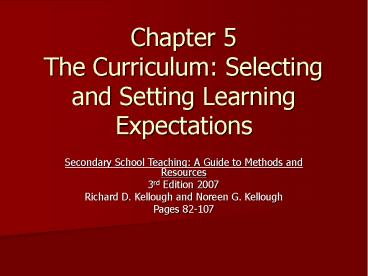Chapter 5 The Curriculum: Selecting and Setting Learning Expectations - PowerPoint PPT Presentation
Title:
Chapter 5 The Curriculum: Selecting and Setting Learning Expectations
Description:
The Curriculum: Selecting and Setting Learning Expectations ... is learning by doing and is thinking abut what she or he is learning and doing' ... – PowerPoint PPT presentation
Number of Views:123
Avg rating:3.0/5.0
Title: Chapter 5 The Curriculum: Selecting and Setting Learning Expectations
1
Chapter 5The Curriculum Selecting and Setting
Learning Expectations
- Secondary School Teaching A Guide to Methods and
Resources - 3rd Edition 2007
- Richard D. Kellough and Noreen G. Kellough
- Pages 82-107
2
The Curriculum Selecting and Setting Learning
Expectations
- Hands-On Learning- The learner is learning by
doing and is thinking abut what she or he is
learning and doing - Hands-On Learning for the student
- Encourages students to question
- Encourages students to investigate, explore and
discover
3
Program Organization Providing Successful
Transitions (pg.162)
- Curriculum- Planned subject matter, content and
skills to be presented to students, only that
which students learn. - Four programs contribute
- The program of students (courses offered)
- The program of student activities (sports, clubs
and organizations) - The program of services (transportation, meals)
- The hidden curriculum (the unplanned and subtle
message systems within schools - The working definition considers curriculum as
the entire school program (pg.162)
4
Curriculum and Instruction Clarification of
Terms
- Curriculum- associated with the content of the
learning - Instruction-associated with the methods or
strategies- presenting the content to the learner
5
Core Curriculum
- Core Curriculum as defined by Congress No Child
Left Behind Act of 2001 are English, reading or
language arts, mathematics, science, foreign
languages, civics and government, economics,
arts, history, and geography (pg. 162).
6
Interdisciplinary and Thematic UnitsCore
Curriculum
- Interdisciplinary Thematic Units
(ITUs)-combination of NCLBs Core Curriculum - Core Curriculum- facilitates the integration of
subjects of thematic units
7
Core Curriculum(continued)
- Core Curriculum- State mandated, required, must
be covered within the school year - Supplemental Curriculum- Not state mandated by
state standards, dependant upon the teachers
discretion
8
Exploratory Opportunities(pg.162)
- Primarily used in middle schools
- Purpose is to provide a variety of experiences to
assist students in finding their specific areas
of interest
9
Co-Curricular and Extra-Curricular Activities
(pg.163)
- Extra-curricular- clubs and activities, separate
from the school day - Co-curricular-vital to the core curriculum, can
happen at any time before, during, or after
school - Mostly present in middle and high schools
10
Advisory/Homebase Program
- Found in middle-level schools
- Usually a class of 8-12 students who meet for no
less than 20 minutes daily with no interruptions - Purpose is to ensure that each student has adult
advocacy. - Program ensures that each student gets positive
and constructive individual attention.
11
Three Levels for Planning for Instruction
- 1st level-plan for the school year
- 2nd level-plan for the units
- 3rd level-plan for lessons
- Planning should be a collaborative experience.
- Package curriculum programs can provide
guidelines for planning curriculum.
12
Teacher Student Collaboration Team Planning
- Students can collaborative with teacher teams to
assist in planning their own learning. - Student collaborative gives them a sense of
ownership in their own learning.
13
Reasons for Planning (pg.164)
- To ensure curriculum coherence.
- To ensure the curriculum is developmentally
appropriate for the students. - Necessary for efficient and effective teaching.
- To ensure program continuation.
- Gives the teacher a sense of confidence and
completion.
14
Components of an Instructional Plan
- Rationale Component- Statement about why the plan
is important, should be consistent with schools
mission statement. - Goals and Objectives (Standards) Components-
Learning targets, specifics knowledge and skills
to be gained by the student. Should be consistent
with the schools rationale component.
15
Component of an Instructional Plan (Continued)
- Articulation Component- Shows the plans
relationship to the learning that preceded and
the learning experiences that will follow. - Learning Activities Component- Presentation of
organized sequential units. - Resources Component- Listing of resources needed
such as print, electronic sources, or artifacts.
16
Components of an Instructional Plan (continued)
- Assessment Component- appraisal of student
learning, occurs in three parts - Before instruction-Pre-assessment
- During instruction-Formative assessment
- After instruction-Summative assessment
17
Components of an Instructional Plan (continued)
- Special Consideration Component- this is where
you make notes to accommodate to the special
populations of students. - Examples include gifted learners, students with
exceptionalities, English-language learners.
18
Designing Curriculum Documents that Provide
Guidance
- National Curriculum Standards
- State Curriculum Standards
- School or District Benchmark Standards
- Curriculum Frameworks
19
Curriculum Standards
- Curriculum Standards Defined as what students
should know and be able to do (process and
performance).
20
National Curriculum Standards
- Include the following subject areas
- Each group has a related professional
organization - -Arts (AAH-PERD) (NAEA) -History
- -Business (NBEA) -Mathematics (NCTM)
- -Economics (NCEE) -Physical Ed. (NASPE)
- -English/Language Arts (IRA) (NCTM) -Psychology
(APA) - -Foreign Languages (ACTFL) -Science (AAAS)
(NSTA) - -Geography (NCGE) -Technology (NSF) (NASA)
- -Health (Joint Commission for National School
Health)
21
State Curriculum Standards
- Influenced by the national standards each
- Individual state has implemented their own
- standards for various disciplines
22
Curriculum Standards and High-Stakes Testing
- Standardized testing occurs on both the national
and state level - Purpose of statewide standardize testing- to
determine how well students are learning
23
Conclusion
- Curriculum is associated with the content of
student learning as instruction is associated
with the delivery and presentation with the
learner.































